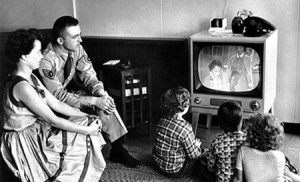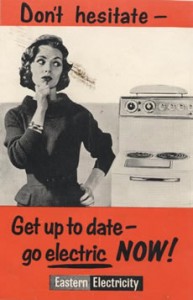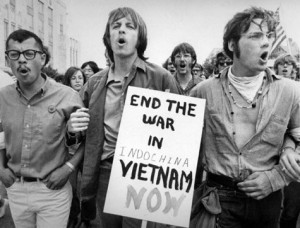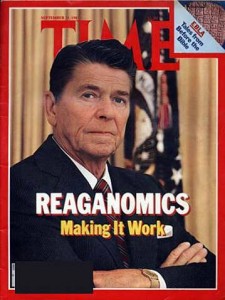View this page in POPjisyo: English => 日本語
Coming Home
 When American soldiers returned home after World War II, many settled into family life.
When American soldiers returned home after World War II, many settled into family life. Birthrates soared. The great number of children born between 1946 and 1965 are known as the baby boom generation. Middle-class white Americans moved to homes in the suburbs. They experienced great prosperity. The automobile, television and other modern conveniences reshaped American life.
Birthrates soared. The great number of children born between 1946 and 1965 are known as the baby boom generation. Middle-class white Americans moved to homes in the suburbs. They experienced great prosperity. The automobile, television and other modern conveniences reshaped American life.
Communism and the Cold War
America waged wars against communism in Korea and Vietnam. Around the world a Cold War (1946-1989) with the Soviet Union was on. At home, suspicions of communist sympathizers brought persecution of American citizens by the House Committee on Un-American Activities, led by Senator Joseph McCarthy.
The Baby Boomers and the Counter Culture
 The baby boom generation came of age in the 1960s. Many voiced their disapproval of the old order. Their search for new values gave birth to a counter-culture in America. The war in Vietnam was a catalyst of student protest. So too was the situation of African Americans in the South. The Civil Rights movement came to a climax during the sixties. A second wave of feminism expressed women’s dissatisfaction with traditional gender arrangements.
The baby boom generation came of age in the 1960s. Many voiced their disapproval of the old order. Their search for new values gave birth to a counter-culture in America. The war in Vietnam was a catalyst of student protest. So too was the situation of African Americans in the South. The Civil Rights movement came to a climax during the sixties. A second wave of feminism expressed women’s dissatisfaction with traditional gender arrangements.
Economic Crisis
In response to America’s support of Israel’s 1973 war, Arab oil-producing countries in the Middle East used price hikes, embargo, and production cuts to increase the price of oil 400% by 1974. Price inflation, stagnating business activity, and unemployment created “stagflation.” People demanded higher wages in response to higher prices, leading to strikes. Voluntary wage and price controls were introduced by President Jimmy Carter. Rising interest rates led to reduced consumer spending. As a result, the U.S. economy went into recession.
Political Change
 Republican Ronald Reagan, a former Hollywood actor and governor of California, was elected president in 1980. Reagan led a conservative social and economic revolution in America. Reagan’s build up of U.S. weapons, a shift to disarmament, and the collaboration of Soviet leader Mikhail Gorbachev helped end the Cold War. “Reagonomics” proposed tax cuts in order to put more money in the hands of the wealthy and increase investment in the economy.
Republican Ronald Reagan, a former Hollywood actor and governor of California, was elected president in 1980. Reagan led a conservative social and economic revolution in America. Reagan’s build up of U.S. weapons, a shift to disarmament, and the collaboration of Soviet leader Mikhail Gorbachev helped end the Cold War. “Reagonomics” proposed tax cuts in order to put more money in the hands of the wealthy and increase investment in the economy.